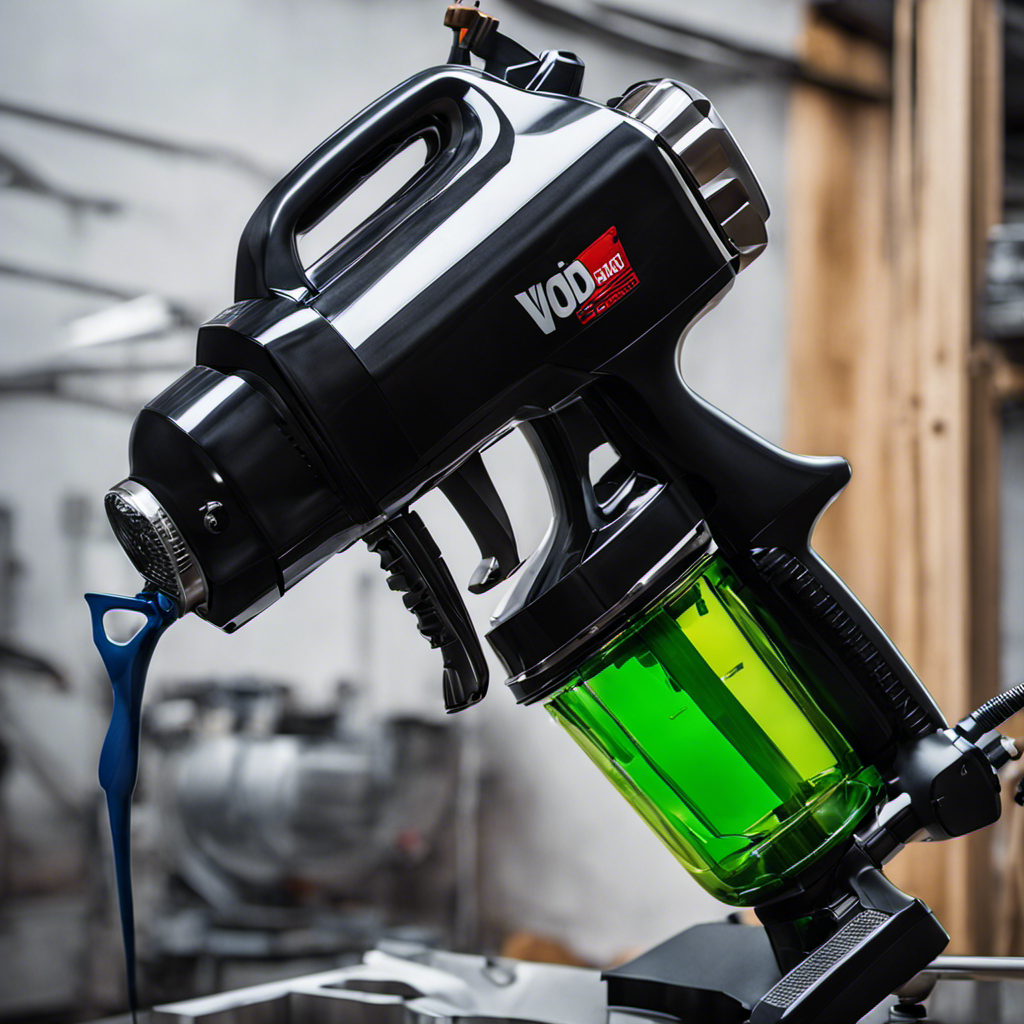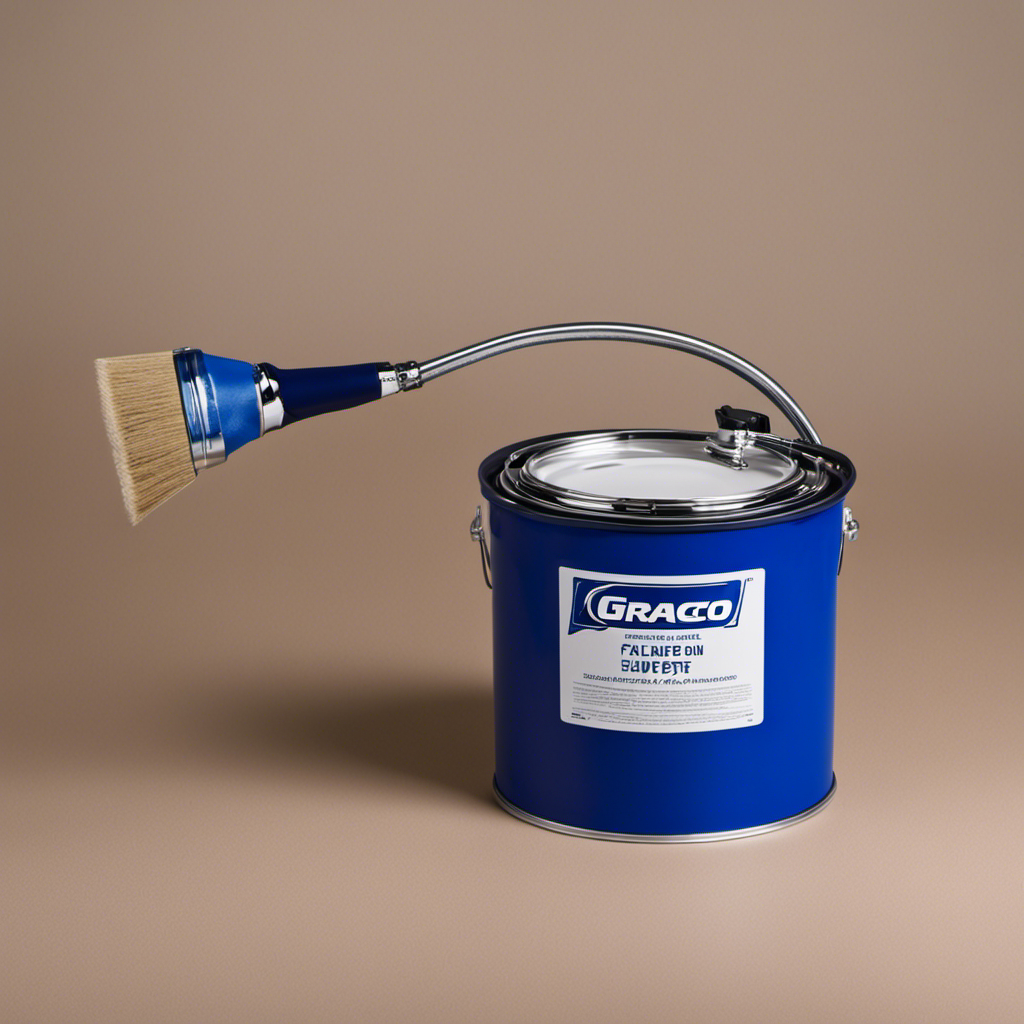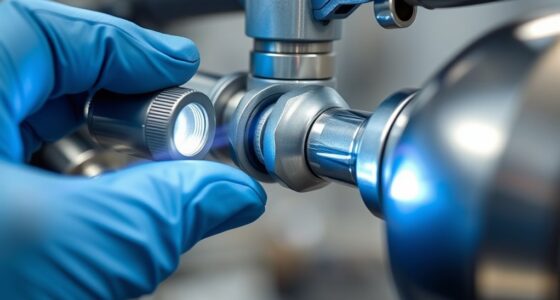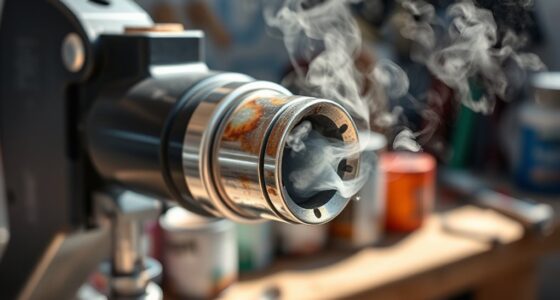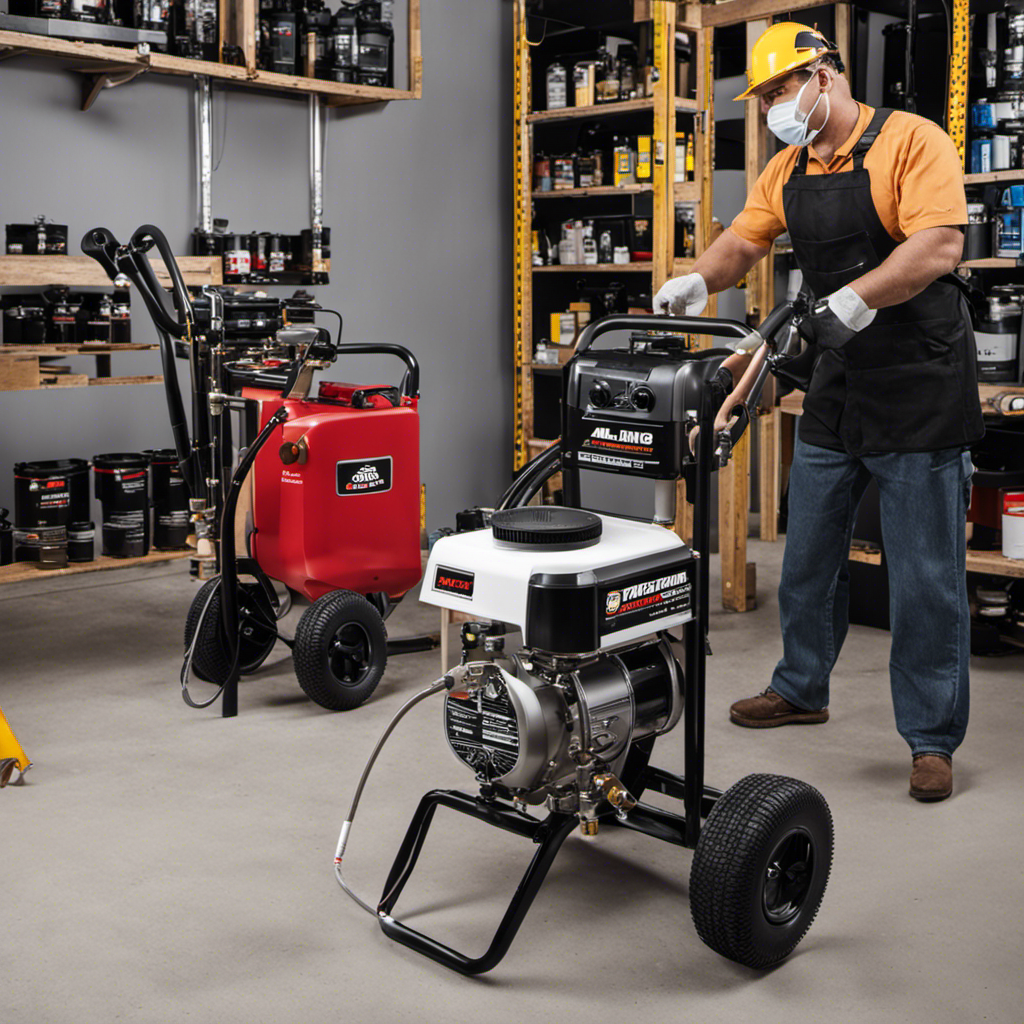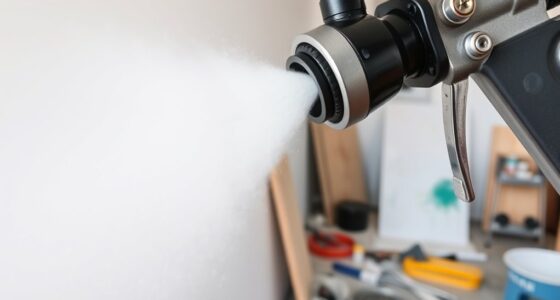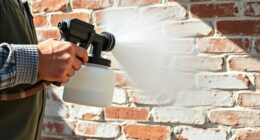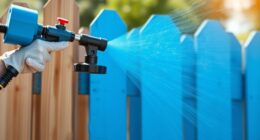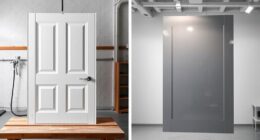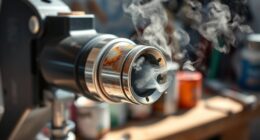An airless paint sprayer, when used by an individual, has the power to turn a plain surface into a work of art, similar to how a magician’s wand works its magic.
Have you ever wondered why it’s called an airless paint sprayer? In this article, I will unravel the mystery behind this powerful tool.
We will explore its history, how it works, key components, advantages, common applications, maintenance, troubleshooting, safety precautions, and even compare it to other painting techniques.
So, sit back and prepare to be amazed by the wonders of the airless paint sprayer.
Key Takeaways
- Airless paint sprayers were designed to overcome the limitations of traditional paintbrushes and rollers.
- They revolutionized the painting industry by increasing productivity and improving overall quality.
- Airless sprayers rely on high pressure to force paint through a small orifice, eliminating the need for compressed air.
- Airless sprayers offer faster application, smoother finish, reduced overspray, and versatility in various projects.
History of Airless Paint Sprayers
The history of airless paint sprayers dates back to the early 20th century. These innovative tools have evolved significantly over time, revolutionizing the painting industry.
Airless paint sprayers were initially designed to overcome the limitations of traditional paintbrushes and rollers, offering a more efficient and time-saving method of applying paint. The introduction of airless paint sprayers had a profound impact on the painting industry, allowing for faster completion of projects with a more consistent and even finish.
The technology behind these sprayers involves pressurizing paint, which is then forced through a small nozzle, creating a fine mist of paint particles. This transitioned the industry from manually applying paint to using a mechanized system that increased productivity and improved overall quality.
Understanding how airless paint sprayers work is key to maximizing their benefits.
How Airless Paint Sprayers Work
To understand how airless paint sprayers work, it’s important to know the basic components involved.
Airless paint sprayers are highly efficient tools that offer numerous benefits and advantages. Unlike traditional paint sprayers that use compressed air to atomize the paint, airless sprayers rely on high pressure to force the paint through a small orifice, creating a fine mist of paint particles.
This method allows for a faster and more even application, resulting in a smooth and professional finish. One of the main advantages of using airless sprayers is their ability to cover large areas quickly, making them ideal for both commercial and residential projects.
Additionally, airless sprayers are versatile and can be used with a wide range of coatings, including latex, enamels, stains, and lacquers.
Now, let’s explore the key components of an airless paint sprayer.
Key Components of an Airless Paint Sprayer
When using an airless paint sprayer, you’ll find that the key components are the motor, the pump, the hose, and the spray gun. These components work together to provide the functionality of the sprayer.
The motor powers the pump, which pressurizes the paint.
The pump draws the paint from the container and pushes it through the hose.
The hose carries the pressurized paint to the spray gun.
The spray gun controls the flow and pattern of the paint, allowing for precise application.
The nozzle at the end of the spray gun atomizes the paint into fine droplets for a smooth finish.
Understanding these components is crucial for using an airless paint sprayer effectively.
Now, let’s explore the advantages of using an airless paint sprayer.
Advantages of Using an Airless Paint Sprayer
If you want a faster and more efficient way to apply paint, you should consider using an airless paint sprayer.
The advantages and benefits of using an airless paint sprayer are numerous. Firstly, it allows for a much faster application of paint compared to traditional methods. The high pressure produced by the sprayer ensures that the paint is evenly distributed and covers a larger area in less time.
Additionally, airless paint sprayers can handle a wide range of coatings, including thick and textured paints, which can be difficult to apply with brushes or rollers. Moreover, using an airless paint sprayer results in a smoother finish with no brush marks or roller lines. It also reduces overspray, minimizing wastage and saving on paint costs.
In the subsequent section, we will explore the common applications of airless paint sprayers.
Common Applications of Airless Paint Sprayers
The most common applications for airless paint sprayers are in large-scale commercial projects. These powerful machines are capable of spraying paint at high pressure, making them ideal for covering large areas quickly and efficiently.
Some of the common applications of airless paint sprayers include:
-
Painting furniture: Airless paint sprayers are perfect for painting furniture as they can evenly coat surfaces, even those with intricate designs or hard-to-reach areas.
-
Exterior house painting: When it comes to painting the exterior of a house, airless paint sprayers are the go-to choice. They can easily cover large surfaces like walls and roofs in a short amount of time.
-
Industrial painting: Airless paint sprayers are commonly used in industrial settings for painting large machinery, equipment, or structures.
-
Commercial painting: Whether it’s painting a shopping center, office building, or warehouse, airless paint sprayers are highly efficient for commercial painting projects.
-
Automotive painting: Airless paint sprayers can provide a smooth and professional finish when painting vehicles, making them a popular choice in the automotive industry.
When it comes to choosing the right airless paint sprayer for your project, there are several factors to consider.
Choosing the Right Airless Paint Sprayer for Your Project
When it comes to choosing the right airless paint sprayer for your project, it’s important to understand the different types available. Each type has its own features and capabilities, making them suitable for specific applications. To help you make an informed decision, here is a table outlining the different types of airless paint sprayers and their recommended uses:
| Type | Recommended Use |
|---|---|
| Airless Piston Pump | Ideal for large projects |
| Airless Diaphragm | Great for spraying thick coatings |
| Airless High Volume | Perfect for high-speed coverage |
| Airless Low Volume | Suitable for detailed work |
| Airless HVLP | Provides a fine finish |
Tips for Properly Using an Airless Paint Sprayer
When it comes to using an airless paint sprayer, there are several painting technique tips that can help you achieve a smooth and even finish.
It’s important to avoid common mistakes such as spraying too close or too far from the surface, as this can result in uneven coverage or overspray.
Additionally, proper cleaning and maintenance of the sprayer is essential to ensure its longevity and optimal performance.
Painting Technique Tips
To achieve a smooth finish, try adjusting the nozzle of your airless paint sprayer for a more controlled spray pattern. This technique can significantly improve the overall quality of your painting job.
Here are some additional painting technique tips to help you achieve professional results:
- Maintain a consistent distance between the sprayer and the surface being painted.
- Apply the paint using overlapping strokes to ensure even coverage.
- Keep the sprayer moving at a steady pace to avoid pooling or uneven application.
- Start and stop the sprayer off the surface to prevent drips or excessive buildup.
- Practice on a scrap surface to get a feel for the sprayer and adjust your technique accordingly.
By following these painting technique tips, you can enhance your painting preparation and increase your chances of achieving a smooth finish.
Now, let’s move on to common mistakes to avoid when using an airless paint sprayer.
Common Mistakes to Avoid
If you don’t maintain a consistent distance, you may end up with uneven coverage when using an airless paint sprayer. One of the most common mistakes people make is holding the sprayer too close to the surface being painted. This can result in excessive paint buildup and an uneven finish. On the other hand, holding the sprayer too far away can lead to overspray and wasted paint.
To achieve the best results, it is important to follow some best practices. First, ensure that you are holding the sprayer at the recommended distance from the surface, which is usually around 12 inches. Second, move the sprayer in a smooth and controlled motion, overlapping each pass by about 50% to ensure even coverage.
Now that you know how to avoid common mistakes, let’s move on to cleaning and maintenance tips for your airless paint sprayer.
Cleaning and Maintenance Tips
Properly maintaining your airless paint sprayer is essential for its longevity and optimal performance. Here are some cleaning techniques and the best cleaning products to keep your sprayer in top shape:
- Use a solvent or cleaning solution recommended by the manufacturer to clean the pump, hoses, and gun.
- Flush the system with clean water or solvent after each use to prevent paint residue buildup.
- Clean the filters regularly to ensure proper paint flow and prevent clogs.
- Inspect the spray tip for any blockages or wear and replace if necessary.
- Store your sprayer in a clean and dry environment to prevent damage and corrosion.
By following these cleaning techniques and using the best cleaning products, you can ensure that your airless paint sprayer stays in excellent condition.
In the next section, we will explore the maintenance and cleaning of airless paint sprayers in more detail.
Maintenance and Cleaning of Airless Paint Sprayers
When it comes to maintaining and cleaning an airless paint sprayer, there are a few key points to keep in mind.
Proper nozzle maintenance is essential for ensuring a smooth and consistent spray pattern.
It’s also important to use the right cleaning solution for your specific sprayer, as using the wrong product can damage the equipment.
Lastly, taking preventative measures to avoid clogs and blockages will help keep your sprayer running efficiently and extend its lifespan.
Proper Nozzle Maintenance
To maintain your paint sprayer’s nozzle, you need to regularly clean it and replace any worn-out parts. Proper nozzle care is crucial for achieving optimal spray patterns and preventing clogs or uneven spraying. Here are some troubleshooting tips to ensure your nozzle stays in top shape:
-
Check for debris: Before and after each use, inspect the nozzle for any paint or debris buildup. Clean it thoroughly with a soft brush or a nozzle cleaning tool.
-
Clear clogs: If the nozzle is clogged, remove it and soak it in a cleaning solution or use a nozzle cleaning needle to unclog it gently.
-
Replace worn-out parts: Over time, the nozzle tip and seal may wear out. Replace them as needed to maintain consistent spray performance.
-
Use the correct nozzle size: Different projects require different nozzle sizes. Make sure to use the appropriate size for the type of paint and desired finish.
-
Store properly: After cleaning, store the nozzle in a clean, dry place to prevent damage.
Now, let’s move on to cleaning solution recommendations for your paint sprayer.
Cleaning Solution Recommendations
You can use a mixture of vinegar and water as a cleaning solution for your nozzle. This cleaning solution is not only effective but also eco-friendly. Vinegar is a natural disinfectant and can help remove any paint residue or buildup from the nozzle.
Simply mix equal parts vinegar and water in a container and soak the nozzle for about 30 minutes. After that, gently scrub the nozzle with a brush to remove any remaining paint particles. Rinse it thoroughly with clean water and let it dry before reattaching it to your airless paint sprayer.
Preventing Clogs and Blockages
To prevent clogs and blockages when using an airless paint sprayer, there are a few important steps to follow.
First, make sure to choose the right paint for your sprayer. Using a paint that is too thick or contains particles can lead to clogs. Additionally, it is crucial to properly thin the paint according to the manufacturer’s instructions. This will help the paint flow smoothly through the sprayer without causing blockages.
Another tip is to regularly clean the filters and nozzles of your sprayer to remove any debris or dried paint that could cause clogs. Finally, using a tip with the correct size for your project can help prevent overspray and ensure a more even application.
Now, let’s move on to troubleshooting common issues with airless paint sprayers…
Troubleshooting Common Issues With Airless Paint Sprayers
If your airless paint sprayer is experiencing common issues, troubleshooting can help identify and resolve the problem. Here are some troubleshooting tips for airless paint sprayers.
First, check the power source and make sure it is properly connected. If the sprayer is not turning on, check the fuse or circuit breaker.
Next, inspect the spray tip for any clogs or blockages. Clean the tip if necessary. Also, check the paint filter and ensure it is clean and free from debris.
If the sprayer is not priming, check the suction tube for any obstructions.
Lastly, make sure the paint is properly mixed and thinned according to the manufacturer’s instructions.
By following these troubleshooting steps, you can quickly identify and resolve common issues with your airless paint sprayer.
Now, let’s move on to discussing safety precautions when using an airless paint sprayer.
Safety Precautions When Using an Airless Paint Sprayer
When using an airless paint sprayer, it’s important to follow safety precautions to protect yourself and others. Here are some precautions to keep in mind:
-
Wear protective gear: Always wear safety glasses, gloves, and a respirator to prevent any paint or fumes from coming into contact with your eyes, skin, or lungs.
-
Ventilate the area: Make sure the painting area is well-ventilated to minimize the inhalation of paint fumes.
-
Secure the work area: Clear the area of any potential hazards, such as tripping hazards or flammable materials, to ensure a safe working environment.
-
Proper equipment handling: Familiarize yourself with the operating instructions of the airless paint sprayer and handle the equipment with care to prevent accidents.
-
Clean up properly: After completing your painting project, clean the sprayer thoroughly and dispose of any paint or solvents in accordance with local regulations.
By following these precautions and handling the equipment responsibly, you can ensure a safe and successful painting experience.
Now, let’s explore how airless paint sprayers compare to other painting techniques.
Comparing Airless Paint Sprayers to Other Painting Techniques
Comparing airless paint sprayers to other painting techniques, there are several factors to consider.
Airless sprayers offer numerous benefits that make them a popular choice among painters. Firstly, they provide a faster and more efficient way of painting large surfaces. The high-pressure system of airless sprayers enables them to cover a larger area in less time compared to traditional methods like brushes or rollers.
Additionally, airless sprayers offer a more even and consistent finish, avoiding brush marks or roller lines. They also allow for greater control over the application of paint, with adjustable pressure settings that can be tailored to different surfaces and materials.
Moreover, airless sprayers can handle thicker coatings, such as latex or enamel, making them versatile for various painting projects.
Overall, the benefits of airless sprayers make them a valuable tool for professional painters.
Frequently Asked Questions
What Are Some Alternative Painting Techniques to Using an Airless Paint Sprayer?
Some alternative painting techniques to using an airless paint sprayer include sponge painting and stenciling. These methods can create unique textures and patterns on surfaces, allowing for creativity and personalization in your painting projects.
Are There Any Safety Precautions Specific to Using an Airless Paint Sprayer?
When using an airless paint sprayer, it’s crucial to follow safety precautions. Properly ventilate the area, wear protective gear, and keep a safe distance from the spray. These measures ensure a smooth and accident-free painting experience.
How Do You Choose the Right Airless Paint Sprayer for a Specific Project?
When choosing the right airless paint sprayer for a specific project, there are several factors to consider. It’s important to think about the size and type of the project, the type of paint being used, and the desired finish.
What Are Some Common Issues That Can Occur When Using an Airless Paint Sprayer?
When using an airless paint sprayer, common issues can arise. However, with proper troubleshooting techniques, these problems can be easily resolved. Let me share some of the most common issues and how to fix them.
How Do You Properly Clean and Maintain an Airless Paint Sprayer?
To properly clean and maintain an airless paint sprayer, start by flushing out any leftover paint and cleaning the filters. Regularly check for clogs and wear, and replace any worn parts. Following these tips will help prolong the lifespan of your sprayer.
Conclusion
In conclusion, airless paint sprayers are a practical and efficient solution for painting projects. With their high-pressure technology, they provide a smooth and even finish, saving both time and paint.
An interesting statistic to note is that airless paint sprayers can cover up to 10 times more surface area compared to traditional paintbrushes or rollers. So, if you’re looking to tackle a large painting job, investing in an airless paint sprayer can greatly increase your productivity.
Drenched in creativity and armed with a fountain pen, Isolde weaves words as gracefully as a painter strokes their canvas. A writer for Paint Sprayer Zone, her passion for colors, textures, and spaces finds a harmonious blend with her profound knowledge of painting tools and techniques.
Having grown up in a family of artists, Isolde’s tryst with paints began early. While her relatives expressed themselves on canvas, Isolde found her medium in words. She dedicated herself to chronicling the world of painting, understanding the nuances of each tool, and the artistry behind every spritz of a paint sprayer.
